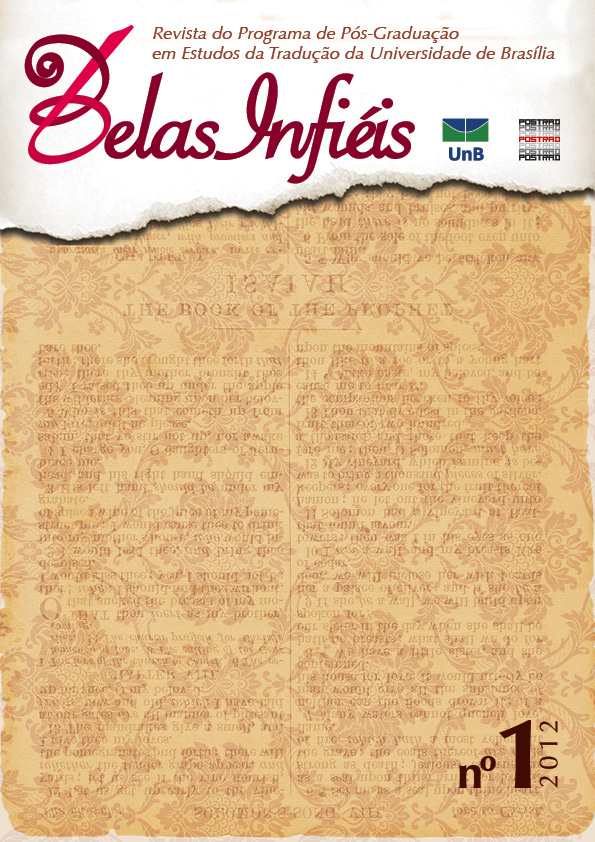A TRADUÇÃO COMO RECURSO EM ATIVIDADES DE UM LIVRO DIDÁTICO DE LÍNGUA INGLESA
DOI:
https://doi.org/10.26512/belasinfieis.v1.n1.2012.11170Palabras clave:
Abordagem Funcionalista de Tradução, Categorias de Tradução, Ensino de Línguas EstrangeirasResumen
Este trabalho tem o objetivo de analisar atividades propostas em um livro didático de língua inglesa como língua estrangeira que abordem categorias de tradução. A partir da análise das atividades foi possível perceber o uso frequente de recursos tradutórios que auxiliam no aprendizado de língua estrangeira (LE). Esta pesquisa está fundamentada na Abordagem Funcionalista de Tradução e nas Categorias de Tradução. As atividades foram selecionadas levando em consideração as categorias de tradução. A análise demonstrou que o uso da tradução por meio das categorias intralingual e interlingual não é tão explorado no nível inicial de aprendizado de língua inglesa. Identificou-se que o uso mais recorrente no material investigado é o da categoria de tradução intersemiótica, representando 82% de frequência nas atividades analisadas. Conclui-se que, no nível básico de aprendizado de LE, o uso de imagens, fotos, cores e demais elementos não verbais são um auxílio fundamental para o desenvolvimento de língua inglesa.
Descargas
Citas
BRANCO, S. O.Asfaces e funções da tradução em sala de aula de língua estrangeira.Cadernos de Tradução, V. XXVII, n. 1, 2011.
CLANDFIELD, L.;LATHAN-KOENIG, Christina;OXDEN; C. TARGET; F. SELIGSON, P. New english file”“Elementary ”“Student’s Book. Oxford: Oxford University Press. 2007.
CORACINI, M. J.R. F. O sujeito tradutor entre a “sua” língua e a língua do outro.Cadernos de Tradução, v.XVI, n. 2, p. 9-24, 2005.
DALBEN, T. P. S. Tradução e ensino-aprendizado de língua inglesa: leitura e análise contrastiva como exercícios de construção de significados.In: ROCHA, L.H.P.; LINS, M.P.P.(Org.). Revista (Con)textos linguísticos,Vitória,n. especial,p.135-144, 2009.
GATENBY, E. V. Popular Fallacies in the Teaching of Foreign Languages. In: LEE, W. R. (ed.) E.L.T. Selections 2: Articles from the Journal ‘English Language Teaching’. London: Oxford University Press. 1967.p. 21-29.
HALLIDAY, M. A. K. Introduction toFunctional Grammar. London: Arnold, 1985.
JAKOBSON, R. Linguística e comunicação. Tradução de Izidoro Blikstein e José Paulo Paes. São Paulo: Cultrix, 2005.
JAKOBSON, R. On Linguistic Aspects of Translation. In: VENUTI, L. (Ed.). The Translation Studies Reader. London: Routledge, 2000. p. 113-118.
HURTADO ALBIR, A. Hacia un enfoque comunicativo de la traducción. II Jornadas Internacionales de Didáctica de Español Lengua Extranjera. Ministerio de Cultura. Madrid, p. 53-79, 1998.
HURTADO ALBIR, A. La traducción en la enseñanza comunicativa. Cable: revista de didáctica del español como lengua extranjera,Madrid,p. 42-45, 1998a.
LADO, R. Language Teaching: A Scientific Approach. New York: McGraw-hill, Inc. 1964.
LEFFA, V. Metodologia do ensino de línguas. In:BOHN H. I; VANDRESEN, P. Tópicos em linguística aplicada: o ensino de línguas estrangeiras. Florianópolis: Ed. da UFSC. 1998, p. 211-236.
LUCINDO, E. S. Tradução e ensino de línguas estrangeiras, 1997. Disponível em:<http://www.scientiatraductionis.ufsc.br/ensino.pdf>. Acesso em:28abr.2009.
MALMKJAER, K. Translation and Language Teaching. Language Teaching and Translation.UK: St. Jerome, 1998.
MASON, I. Communicative/Functional Approaches. In: BAKER, M.Routledge Encyclopedia of Translation Studies. London: Routledge, 1998.
NORD, C. Text Analysis in Translation:Theory, Methodology, and Didactic Application of a Model for Translation-Oriented Text Analysis. Amsterdam: Rodopi, 1991.
NORD,C. Translating as a purposeful activity. Manchester: St. Jerome, 1997.
PEUGENAUTE, L. La traducción como herramienta didáctica.Contextos, Madrid, n.27-28, p. 107-126, 1996.
REISS, K.; VERMEER, H. J.Grundlegung einer Allgemeinen Translationstheorie. Tübingen: Niemeyer, 1984.
Descargas
Publicado
Cómo citar
Número
Sección
Licencia
Copyright Statement
Given the public access to this journal, the texts are free to use but requires the recognition of the original authorship and initial publication in this journal to be properly stated.
The journal allows the use of works published for non-commercial purposes, including the right to submit the work to publicly accessible databases. Published contributions are the sole and exclusive responsibility of the author(s).
- When submitting papers to be evaluated by the Belas Infiéis journal, the author(s):
- Declare that the contents of the contributions are original and of their original creation, being entirely responsible for their content if there is an objection by third parties.
- Claim to be aware that they should not commit academic plagiarism.
- Declare that the manuscript has not been published, completely or partially, in Portuguese or another language. If it is a translation it should be submitted to the Translated Articles section.
- Declare that the manuscript is not being evaluated by other journals.
- Declare that the manuscript was not submitted to another journal simultaneously.
- Commit(s) to inform the journal of any kind of error or inaccuracy in their contribution (published, in evaluation or in editing) and to collaborate with the editors to make due corrections of the article (when in evaluation or editing) or erratum/retraction (after publication).
- Declare that there is no conflict of interest regarding the published work.
- Authorize its release if it is accepted for publication without any kind of monetary compensation.
- Agree to assign non-exclusive rights to publication to the magazine, remaining free to make their contribution available in other media as long as the publication of the first version in Belas Infiéis magazine is mentioned. They also authorize Belas Infiéis to assign their texts for reproduction in content indexers, virtual libraries and similar platforms.
- Maintain copyright and grant the journal the right of first publication, the work being licensed under theCreative Commons Attribution License.
- Is/Are allowed and encouraged to publish and distribute their work online after the editorial process, which may increase the impact and citation of the published work.
- Authorize the editorial team to make textual adjustments and to adapt the article to the publication rules, when necessary.



















